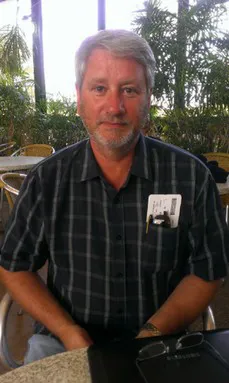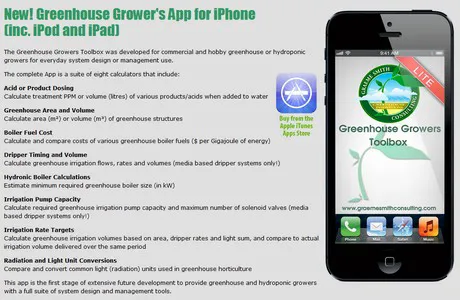 In the last decade Australian horticulture has seen a big shift from field-grown produce to greenhouse production, with supermarkets indicating they want growers to double the supply of tomatoes in coming years.
In the last decade Australian horticulture has seen a big shift from field-grown produce to greenhouse production, with supermarkets indicating they want growers to double the supply of tomatoes in coming years.Graeme Smith, an Australian ex-grower and now the owner of Graeme Smith Consulting (Greenhouse Innovations), will be hosting a series of seminars in the UK designed to provide growers with real solutions to production issues, which will run for five days in June.
Meanwhile back in his native Australia, Graeme is heavily involved in a project just outside of Melbourne to develop a 400 hectare greenhouse precinct.
“The project is under development now to encourage investors to come and share staff, energy, packing halls, and freight. All the resources [will be] in this one location in Victoria.
“It’s early days yet, they’re still going through all the planning stages and working with the ministers and so on but there’s intent to create what I’ve termed a little bit of a mini Westland,” he says.
But this new 400 hectare horti park, could merely replace the current shortfall in tomato production left by the decline in field-grown produce since three of the country’s biggest outdoor tomato growers have gone into receivership in the last three years.
Graeme attributes this to three main reasons: from extreme weather (storms and cyclones) brought on by climate change, to an increase in the cost of production, and thirdly, modern greenhouses steadily chipping away at the open-field producers’ traditional market.
“While we have a different product i.e. greenhouse tomatoes versus open-field tomatoes, volumes from different sectors certainly affect each other at different times of the year – there can be quite a difference in price,” which Graeme blames for the decline in open-field revenues.
10 years ago, Graeme describes the majority of commercial producers as ‘mum and dad operations’, but now most of the bigger enterprises are typically larger corporate companies, with some greenhouses covering 30 hectares. One in particular he says, is planning a new build that will eventually mean they have 40 hectares of greenhouses. The majority of these enterprises are using Dutch glasshouse production technology.
This all suggests that Graeme’s knowledge (much of which has been learned from the Dutch industry during many visits to Holland) will be in big demand as companies modernize and expand their greenhouses. But unlike Dutch consultants, Australian advisors can’t just specialise in one crop.
“At one stage I had about 65 clients with all different crops.”
“Here we’re spread all over Australia with lots of distance to travel and lots of different crops, so as an advisor, we have to try and learn as much as possible about whether it’s leafy greens or vine crops, cut flowers, or whatever,” Graeme says.
Australian growers also have to contend with stringent policies on importing biological control – this includes bumblebees for pollination – because the government is extremely protective of the nation’s environment and eco system.
“We cannot bring anything in unless there’s a very strong case to prove there are no adverse effects on the local flora and fauna which takes a very long time and lots of research,” he says.
“It’s very difficult to get in a biologically beneficial insect, so what we have to do is look for local alternatives and in a lot of cases we have.”
Bumble bees are a case in point here, because they are not indigenous to Australia.
Despite their discovery in Tasmania in 1992 (and thought to have found its way to the island from New Zealand), the Australian government has so far prohibited their import to the mainland.
This means that Australian tomato growers still have to rely on battery-powered buzz pollinators, with a labour cost of $25,000 (AUD) per hectare according to Smith.
“We predict that if we had bumble bees it may only be around $7,000 per hectare so it’s a big cost to us,” he says, although he firmly believes that bumble bees will inevitably find their own way to the Australian mainland one day.
“They’ll island hop eventually anyway and will end up coming to the mainland naturally, I have no doubt in time,” he predicts confidently.
iPhone app
And when he’s not advising Australian growers, Graeme has also found time to develop a commercial growing app for the iPhone (based on studies he conducted in Holland) that includes 8 different calculators that can be used by a grower for day to day activities or as a simple design tool for new greenhouse developments. For example, the app can calculate heatloads and calorific values of fuels. etc which has since been sold to growers in America, England, China, New Zealand and Russia. (to name a few)
He also offers climate and financial feasibility studies to clients around the world because he is used to dealing with a range of climates in Australia, which varies from tropical to temperate across the country; and this too has been popular in places like Jordan, Hong Kong, China, South Africa, America, UK and India.
“It’s important for them to understand their climate and what they need to grow this crop; what it’s going to cost and if you can you make a dollar at the end of it,” he says.
“In greenhouses, whilst there are specific differences for management of different crops, at the end of the day the underlying principles are still the same.
“Plant physiology and environmental management is still similar whatever the crop, there just might be some differences in the targets. So even though I might not have been an expert on the individual crops I’ve had enough knowledge to be able to help them in a lot of ways to improve productivity and quality,”
My key aim is to try and bring solutions to industry whether that be growers, researchers, investors, suppliers or governments, Graeme concludes.
 For more information:
For more information:Graeme Smith Consulting
Graeme Smith (CPAg)
graeme@graemesmithconsulting.com
www.graemesmithconsulting.com
